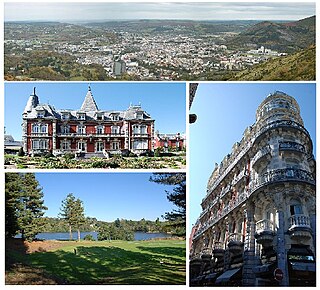
Lourdes is a market town situated in the Pyrenees. It is part of the Hautes-Pyrénées department in the Occitanie region in southwestern France. Prior to the mid-19th century, the town was best known for its Château fort, a fortified castle that rises up from a rocky escarpment at its center.

The Most Sacred Heart of Jesus is one of the most widely practised and well-known Catholic devotions, wherein the heart of Jesus Christ is viewed as a symbol of "God's boundless and passionate love for mankind". This devotion to Christ is predominantly used in the Catholic Church, followed by high church Anglicans, and some Western Rite Orthodox. In the Latin Church, the liturgical Solemnity of the Most Sacred Heart of Jesus is celebrated the third Friday after Pentecost. The 12 promises of the Most Sacred Heart of Jesus are also popular.
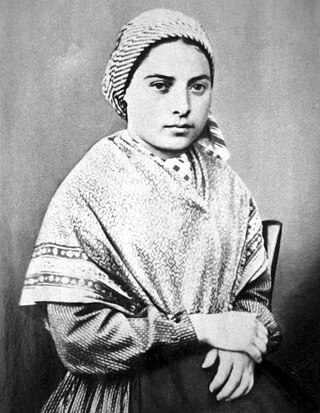
Bernadette Soubirous, also known as Bernadette of Lourdes, was the firstborn daughter of a miller from Lourdes, in the department of Hautes-Pyrénées in France, and is best known for experiencing apparitions of a "young lady" who asked for a chapel to be built at the nearby cave-grotto. These apparitions occurred between 11 February and 16 July 1858, and the young lady who appeared to her identified herself as the "Immaculate Conception".

Our Lady of Fátima is a Catholic title of Mary, mother of Jesus, based on the Marian apparitions reported in 1917 by three shepherd children at the Cova da Iria in Fátima, Portugal. The three children were Lúcia dos Santos and her cousins Francisco and Jacinta Marto. José Alves Correia da Silva, Bishop of Leiria, declared the events worthy of belief on 13 October 1930.

The Cathedral Church and Minor Basilica of Saint Patrick is the cathedral church of the Roman Catholic Archdiocese of Melbourne in Victoria, Australia, and seat of its archbishop, currently Peter Comensoli.

The Sanctuary of Our Lady of Lourdes is a Catholic Marian shrine and pilgrimage site dedicated to Our Lady of Lourdes in the town of Lourdes, Hautes-Pyrénées, France. The sanctuary includes several religious buildings and monuments around the grotto of Massabielle, the place where the events of the Lourdes apparitions occurred in 1858, among them are three basilicas, the Basilica of Our Lady of the Immaculate Conception, the Rosary Basilica and the Basilica of St. Pius X, respectively known as the upper, lower and underground basilica.

The National Basilica of the Sacred Heart is a Catholic minor basilica and parish church in Brussels, Belgium. It is dedicated to the Sacred Heart, inspired by the Basilique du Sacré-Cœur in Paris. Symbolically, King Leopold II laid the first stone in 1905 during the celebrations of the 75th anniversary of Belgian independence. The construction was halted by the two world wars and finished only in 1970. Belonging to the Metropolitan Archdiocese of Mechelen–Brussels, it is the 14th largest church by area in the world and the largest in Belgium.

The Basilica of the Sacred Heart in Notre Dame, Indiana, is a Catholic church on the campus of the University of Notre Dame, also serving as the mother church of the Congregation of Holy Cross (C.S.C.) in the United States. The neo-gothic church has 44 large stained glass windows and murals completed over a 17-year period by the Vatican painter Luigi Gregori. The basilica bell tower is 230 feet (70 m) high, making it the tallest university chapel in America. It is a contributing building in Notre Dame's historic district listed on the National Register of Historic Places. The basilica is a major tourist attraction in Northern Indiana, and is visited annually by more than 100,000 tourists.
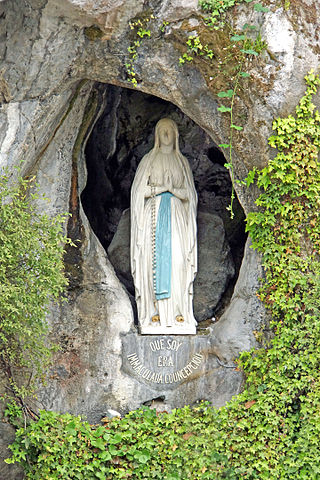
Our Lady of Lourdes is a title of the Virgin Mary. She is venerated under this title by the Roman Catholic Church due to her apparitions that occurred in Lourdes, France. The first apparition of 11 February 1858, of which Bernadette Soubirous told her mother that a "Lady" spoke to her in the cave of Massabielle while she was gathering firewood with her sister and a friend. Similar apparitions of the "Lady" were reported on 18 occasions that year, until the climax revelation in which she introduced herself as: "the Immaculate Conception". On 18 January 1862, the local Bishop of Tarbes Bertrand-Sévère Laurence endorsed the veneration of the Blessed Virgin Mary in Lourdes.
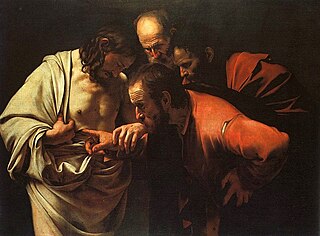
A number of people have claimed to have had visions of Jesus Christ and personal conversations with him. Some people make similar claims regarding his mother, Mary. Discussions about the authenticity of these visions have often invited controversy. The Catholic Church endorses a fraction of these claims, and various visionaries it accepts have achieved beatification, or even sainthood.

The Lourdes apparitions are several Marian apparitions reported in 1858 by Bernadette Soubirous, the 14-year-old daughter of a miller, in the town of Lourdes in Southern France.

TheBasilica of Our Lady of the Rosary is a Catholic church and minor basilica within the Sanctuary of Our Lady of Lourdes in France. Its main theme is a celebration and depiction of the Rosary.

The Mariology of the popes is the theological study of the influence that the popes have had on the development, formulation and transformation of the Roman Catholic Church's doctrines and devotions relating to the Blessed Virgin Mary.
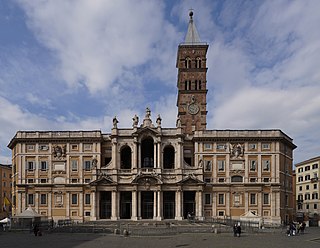
Catholic Marian churches are religious buildings dedicated to the veneration of the Blessed Virgin Mary. These churches were built throughout the history of the Catholic Church, and today they can be found on every continent including Antarctica. The history of Marian church architecture tells the unfolding story of the development of Catholic Mariology.
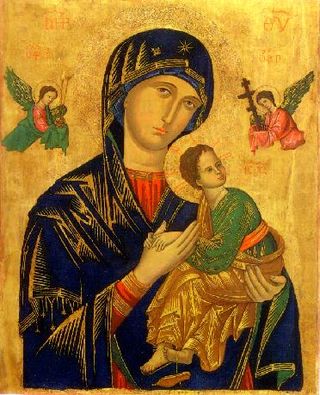
Mary has been one of the major subjects of Western art for centuries. There is an enormous quantity of Marian art in the Catholic Church, covering both devotional subjects such as the Virgin and Child and a range of narrative subjects from the Life of the Virgin, often arranged in cycles. Most medieval painters, and from the Reformation to about 1800 most from Catholic countries, have produced works, including old masters such as Michelangelo and Botticelli.

Le pèlerinage de Lourdes is the only encyclical of Pope Pius XII issued in French. It includes warnings against materialism on the centenary of the apparitions at Lourdes. It was given at Rome, from St. Peter's Basilica, on the feast of the Visitation of the Most Holy Virgin, July 2, 1957, the nineteenth year of his pontificate.
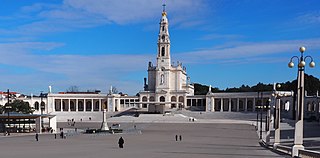
The Sanctuary of Fátima, officially titled Sanctuary of Our Lady of the Rosary of Fátima, is a Marian shrine dedicated to Our Lady of Fatima located in Fátima, in the municipality of Ourém, in Portugal. It consists of a group of Catholic religious buildings and structures with the Basilica of Our Lady of the Rosary as the main building.
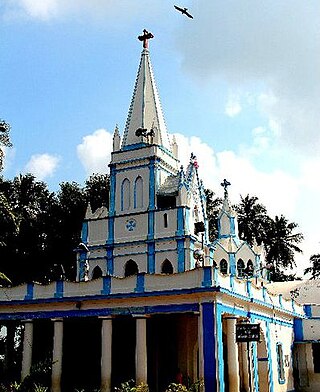
Shrine of Our Lady of Lourdes, Villianur, Puducherry is a Catholic Marian shrine and a parish church in Villianur, Puducherry, India. The shrine is dedicated to the Blessed Virgin Mary under the title of Our Lady of Lourdes.
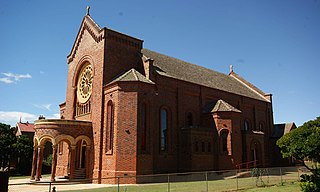
Catholic Church of Christ the King is a heritage-listed Catholic church building located at Macarthur Street, Taralga, Upper Lachlan Shire, New South Wales, Australia. It was designed by Sydney Smith of Ogg & Serpell and built from in 1934 by R. M. Bowcock. It is also known as Church of Christ the King. The property is owned by the Archdiocese of Canberra – Goulburn and was added to the New South Wales State Heritage Register on 30 April 2004.






















